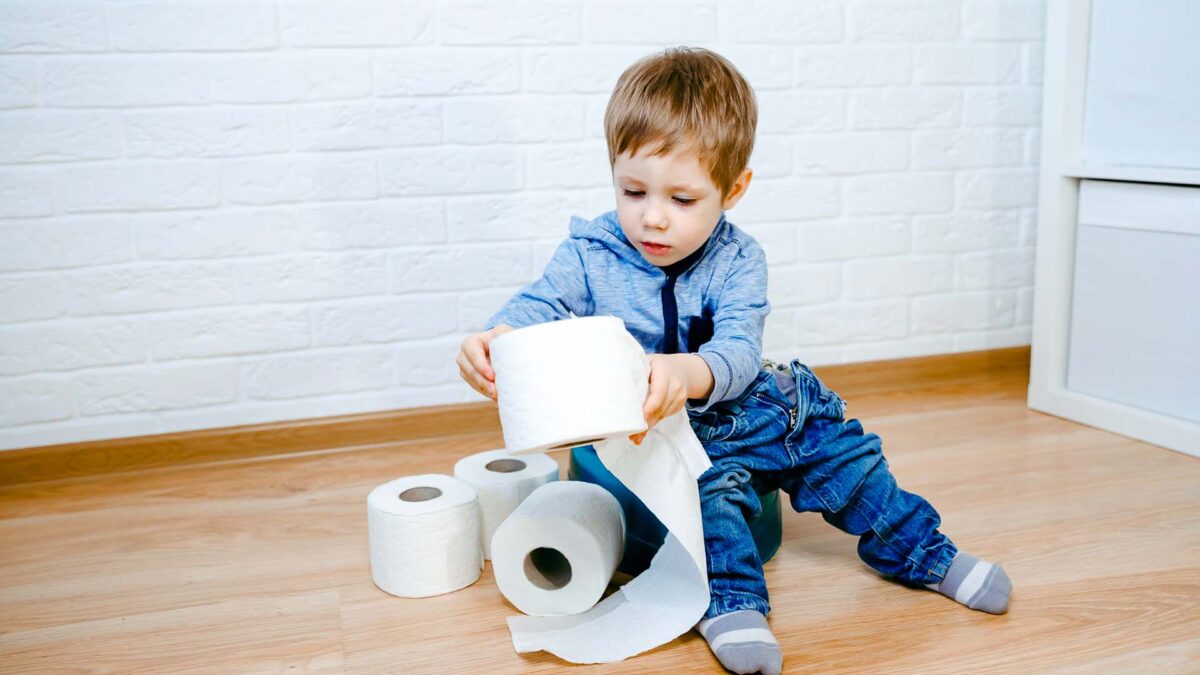Constipation in children is a surprisingly common problem, especially when toilet training. Here’s what to do when faced with a constipated toddler.
If the frequency of the question asked in our Facebook group is anything to go by, our kids are going to experience constipation at one time or another.
Toddlers are especially prone to suffering from constipation, and toilet training or starting solid foods are common causes. Learning to use the toilet can be daunting for younger children, which may cause them to “hold on”. This can cause poo to harden, making it more painful the next time they open their bowels.
Constipation is also common when starting solids as the digestive system needs time to get used to your child’s diet, particularly if they’ve only had breast milk before this.
However, just because it happens regularly doesn’t make it any less painful for your kid. When you have a constipated toddler, you want to get things moving as quickly as possible.
In this video below, GP Dr Simone Kooke tells you everything you need to know when it comes to babies and constipation.
When should you worry about child constipation?
Generally, older children should be having a bowel movement at least once every three days. That saying, every child is different (haven’t we heard that before?), which means some children may go three times a day while others only once every two to three days.
Constipation is less about the frequency and more about the quality. It is possible your child is constipated if they are:
- passing hard stools
- experiencing stomach pain
- not feeling as hungry as usual
- bleeding when doing a poo (caused by anal fissures where the skin around the anus splits due to straining to pass a large, hard poo)
- looking bloated around the tummy area
How to help children’s constipation: 5 solutions
Constipation is often caused by a combination of too much processed foods and not enough fibre (read: fruit and veggies). Here are some ways to increase your child’s fibre intake and bowel movements.
1. Introduce “P” fruits
Not all fruit are created equal when it comes to fibre content. Coincidentally, those with a higher amount of fibre all start with the letter P:
- Prunes
- Pears
- Plums
- Peaches
Depending on your child’s age and willingness to cooperate, you could also serve them in the form of purees or fruit juice. Prune juice or pear juice for constipation can be very effective.
2. Make sure they drink water—and plenty of it
Low fluid intake is a common reason for a child’s constipation woes. Children—and even adults—should be drinking plenty of water. (Babies under six months should be drinking only breast milk or formula.) Increased water intake can help to soften stools, making it easier to poo.
3. Increase fibre intake
Insoluble fibre is the best cure for chronic constipation. This means incorporating plenty of vegetables and wholegrains into your child’s diet. If your child is particularly fussy, hidden veggie recipes are a great way to start. (Tip: Many mums in our group grate zucchini and carrots into muffins or pasta sauce.)
Swap white bread and rice for wholemeal bread and brown rice. Rolled oats and wheat bran are great high-fibre breakfast options.
How do you convince children to eat more vegetables? Nutritionist Amanda Muhl shares her tips in the video below.
4. Remove fear and resort to bribery
Some children—especially those toilet training—end up with constipation simply because they’re afraid of falling into the toilet or have had a painful experience before. Others may prefer to “hold on” because they’d rather be playing or doing something more exciting.
An inset for the toilet seat or a foot stool to rest their legs and feet can help alleviate fears. Encourage them to listen and respond to their body’s urges. Sticker charts or praises are a great way of using positive reinforcements to get them into the habit of using the toilet.
5. Speak to a doctor
If your child has severe constipation, speak with your child’s doctor. They may recommend laxatives, especially if your child’s been constipated for a long time, but these should only be taken under medical advice.
The bottom line
Constipation cures are often not a one-off miracle solution. To help prevent constipation in future, it’s a good idea to ensure your child’s diet is consistently high in fresh food and water, and low in processed foods.

How helpful was this article?
Click on a star to rate it!
0 / 5. 0
Be the first to rate this post!
Melody Tan
Related posts
Subscribe
Receive personalised articles from experts and wellness inspiration weekly!

